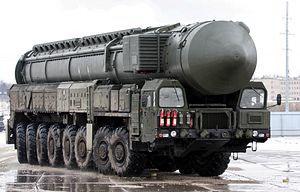Russia’s Minister of Defense Sergei Shoigu announced on February 21 that 90 percent of the country’s strategic nuclear forces will be armed with modern weaponry by 2020, according to local media reports. Shoigu also noted that over 60 percent of the Strategic Missiles Forces will be armed with new weapon systems by late 2020.
The Russian military’s modernization efforts include new missile systems, modern ballistic missile submarines, and upgraded strategic bombers such as the Tupolev Tu-160 and Tu-95MS. “This will allow us to bring the provision of the strategic nuclear forces with modern weaponry to 90 percent as a whole and that of the Strategic Missile Force to 62 percent,” Shoigu said on Tuesday.
Russia currently operates about 20 Tu-95MS bombers and around 16 Tu-160. The Russian Air Force expects the maiden flight of an improved variant of the Tu-160, the Tupolev Tu-160M2, a long-range supersonic strategic bomber, in late 2018. Overall, Russia plans to field up to 50 Tu-160M2s within the next decade. Shoigu expects the combat capability of Russian military aviation to grow by 50 percent by the end of 2020.
“The Air Force will have fifth generation planes, which will increase the combat capabilities of our aviation by 50 percent percent,” Shoigu added. As I noted last month, Russia could receive the first serial-produced fifth-generation T-50 (PAK FA) multi-role fighter jet in 2018. It is intended to replace Russia’s obsolete fleet of MIG-29s and Su-27s.
In 2015, the Russian government announced that it intends to add 40 new intercontinental ballistic missiles per year. As I reported elsewhere (See: “Russian General: Russia Now Fields 400 Intercontinental Ballistic Missiles”):
Independent assessments in 2015 estimated that Russia has around 300 ICBMs deployed with a little over 1,000 warheads. According to an April 2016 estimate by the Bulletin of the Atomic Scientists, “Russia deploys an estimated 307 ICBMs that can carry approximately 1040 warheads, nearly 40 percent of the country’s total strategic warheads.”
Russia plans to conduct over a dozen intercontinental ballistic missile tests in 2017. The last test took place in January of this year and involved a nuclear-capable Topol-M (aka RS12M2/NATO reporting name SS-27), a three-stage solid fueled ICBM with a reported maximum range of about 11,000 kilometers (6,835 miles).
Russia’s deadliest new nuclear weapon currently under development is the RS-28 Sarmat, a new ICBM expected to enter service by 2020. The Sarmat slated to become the he mainstay of the Strategic Missile Force’s silo-based ICBM force. However, as I reported elsewhere, there is some circumstantial evidence that the missile program is encountering technical difficulties and may be delayed.
In his remarks on February 21, Shoigu emphasized Russia is working on improving its precision-guided munition arsenal. “The strike potential of our precision weaponry will increase fourfold by 2021, which will help ensure Russia’s security along the entire perimeter of our borders,” he said.
































